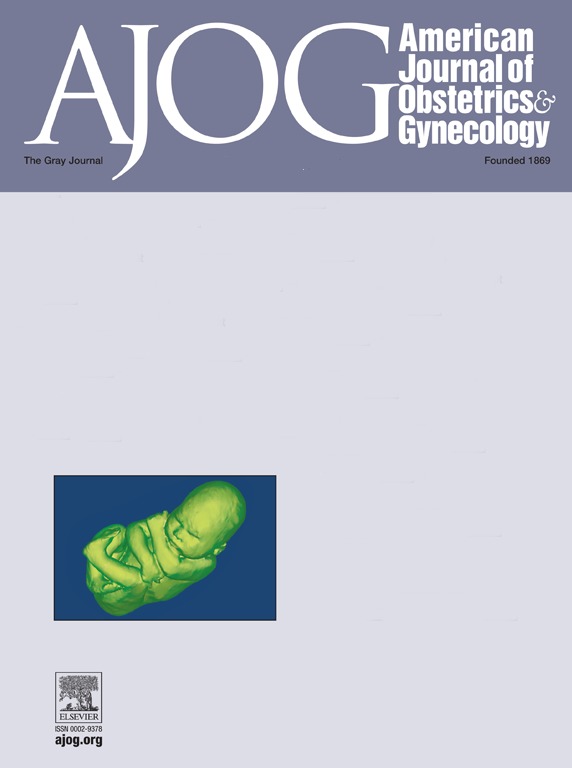分娩窒息后的缺氧缺血性脑病:可以避免吗?
IF 8.7
1区 医学
Q1 OBSTETRICS & GYNECOLOGY
引用次数: 0
摘要
背景:产时胎儿监测期间出现足月缺氧缺血性脑病的比例尚不清楚。此外,最近的Cochrane综述和其他研究强调有必要研究入院时心脏造影的影响,并强调有必要定义“可避免的围产期脑损伤”。目的评价产时窒息对新生儿缺氧缺血性脑病发生的影响,确定采取预防措施后受益的病例比例。研究设计:这项回顾性的20年出生队列研究包括2005年至2024年在芬兰赫尔辛基大学医院地区的7家妇产医院进行的自然足月(≥37周妊娠)单胎分娩的入院和产时心脏摄影记录。在诊断为缺氧缺血性脑病的新生儿中,分娩时窒息的病例在入院时通过正常的心电图来识别,而产前暴露则通过异常的入院心电图来指示。分析脐带血气体、促红细胞生成素和血清S100β浓度,并对胎盘进行组织病理学检查。主要结局为缺氧缺血性脑病。次要结局是胎儿窒息,定义为存在严重或中度酸血症。结果317126例足月新生儿中发现缺氧缺血性脑病314例。入院时心电图正常141例(44.9%),异常173例(55.1%)。在入院时心电图正常的患者中,重度酸血症(脐动脉pH <7.00和/或碱过量≤-12.0 mmol/L)发生在127/141(90.1%),中度酸血症(脐动脉pH 7.09-7.00和碱过量-10.0至-11.9 mmol/L)发生在11/141(7.8%)。排除围产期前哨事件和及时分娩的病例,仍有70例(49.6%)病例可能是在分娩期间发生的缺氧缺血性脑病,被认为是可以避免的。这些结果表明,22.3%(70/314)的患者本应采取预防措施。心动图异常的新生儿脐血中位促红细胞生成素浓度高于心动图正常的新生儿(112 U/L;四分位数区间22-1130 vs. 29 U/L;四分位数范围7 ~ 680,P< 0.001),表明慢性缺氧较多。结论入院时心电图正常的足月新生儿缺氧缺血性脑病,98%可归因于产时窒息。我们的研究结果表明,一半的产时缺氧缺血性脑病的入院心电图正常的病例是可以避免的,这表明五分之一的病例可以从预防措施中受益。研究结果强调了最佳产时护理在预防缺氧缺血性脑病中的作用。本文章由计算机程序翻译,如有差异,请以英文原文为准。
Hypoxic-ischemic encephalopathy following intrapartum asphyxia: is it avoidable?
BACKGROUND
The proportion of term hypoxic-ischemic encephalopathy arising during intrapartum fetal surveillance remains unclear. Moreover, recent Cochrane review and other studies emphasized the need for research on the impact of admission cardiotocography, and highlighted the necessity for a definition of 'avoidable perinatal brain injury'.
OBJECTIVE
To assess the impact of intrapartum asphyxia on neonatal hypoxic-ischemic encephalopathy occurrence and identify the proportion of cases that benefit from preventive measures.
STUDY DESIGN
This retrospective 20-year birth cohort study included admission and intrapartum cardiotocography recordings from spontaneous term (≥37 weeks of gestation) singleton deliveries at seven maternity hospitals within the Helsinki University Hospital area, Finland, between 2005 and 2024. In newborns diagnosed with hypoxic-ischemic encephalopathy, cases following intrapartum asphyxia were identified by a normal cardiotocogram at admission, whereas antepartum exposure was indicated by an abnormal admission cardiotocogram. Cord blood gases, erythropoietin, and serum S100β concentrations were analyzed, and placentas underwent histopathological examination. Primary outcome was hypoxic-ischemic encephalopathy. Secondary outcome was fetal asphyxia, defined as the presence of severe or moderate acidemia.
RESULTS
Among 317 126 term newborns, 314 cases of hypoxic-ischemic encephalopathy were identified. Admission cardiotocogram was normal in 141 (44.9%) and abnormal in 173 (55.1%). Of those with a normal admission cardiotocogram, severe acidemia (umbilical artery pH <7.00 and/or base excess ≤-12.0 mmol/L) evolved in 127/141 (90.1%) and moderate acidemia (umbilical artery pH 7.09-7.00 and base excess -10.0 to -11.9 mmol/L) in 11/141 (7.8%). Excluding cases with a perinatal sentinel event and timely deliveries, 70 cases (49.6%) remained in which hypoxic-ischemic encephalopathy presumably developed during labor and was considered potentially avoidable. These findings suggest that in 22.3% (70/314), preventive measures should have been implemented. Newborns with abnormal cardiotocograms had higher median umbilical blood erythropoietin concentrations than those with normal admission cardiotocograms (112 U/L; interquartile range 22-1130 vs. 29 U/L; interquartile range 7-680, P<.001), indicating more chronic hypoxia.
CONCLUSIONS
Of term newborns with hypoxic-ischemic encephalopathy and normal admission cardiotocogram, 98% were attributable to intrapartum asphyxia. Our findings indicate that half of cases of intrapartum hypoxic-ischemic encephalopathy with a normal admission cardiotocogram were potentially avoidable, suggesting that one-fifth of all cases could have benefited from preventive measures. The findings underscore the role of optimal intrapartum care in preventing hypoxic-ischemic encephalopathy.
求助全文
通过发布文献求助,成功后即可免费获取论文全文。
去求助
来源期刊
CiteScore
15.90
自引率
7.10%
发文量
2237
审稿时长
47 days
期刊介绍:
The American Journal of Obstetrics and Gynecology, known as "The Gray Journal," covers the entire spectrum of Obstetrics and Gynecology. It aims to publish original research (clinical and translational), reviews, opinions, video clips, podcasts, and interviews that contribute to understanding health and disease and have the potential to impact the practice of women's healthcare.
Focus Areas:
Diagnosis, Treatment, Prediction, and Prevention: The journal focuses on research related to the diagnosis, treatment, prediction, and prevention of obstetrical and gynecological disorders.
Biology of Reproduction: AJOG publishes work on the biology of reproduction, including studies on reproductive physiology and mechanisms of obstetrical and gynecological diseases.
Content Types:
Original Research: Clinical and translational research articles.
Reviews: Comprehensive reviews providing insights into various aspects of obstetrics and gynecology.
Opinions: Perspectives and opinions on important topics in the field.
Multimedia Content: Video clips, podcasts, and interviews.
Peer Review Process:
All submissions undergo a rigorous peer review process to ensure quality and relevance to the field of obstetrics and gynecology.

 求助内容:
求助内容: 应助结果提醒方式:
应助结果提醒方式:


